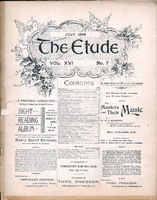IV.
This question is one of interest to teachers and pupils, and with the idea of securing material on the subject The Etude solicited contributions from a number of well-known teachers. Replies were published in The Etude for April, May, and June. The illustrations have added to the value of the series, which will be continued in our next issue.
From MISS REBEKAH CRAWFORD.
My studio is a front alcove-room of goodly size, having three windows. Entering from the hall, near the rear of the room, we face the side of a grand piano, the keyboard of which is opposite the windows. On the same side of the room, toward the right, are an upright grand and a table holding The Etudes of twelve years, in twelve handsomely bound volumes.
Turning from this side of the room to the right, we face the front wall and windows. Between two of the latter stands a substantial desk, beside this another table of books, in front of which is placed the keyboard table; to the right of these an inviting couch well supplied with pillows.
Next we enter the alcove on the same side as the door by which we entered. Across one corner stands a tapestry screen, about nine by five feet, on which is painted the garden scene from ” Mignon.” In the alcove is also a large cabinet.
Still keeping to the right, we perceive against the rear wall of the alcove, and that of the main room as well, receptacles for music, the two containing twenty-six drawers, alphabetically placed, in which a vast quantity of music is arranged in like manner; the duet stool, too, has a box-seat for holding music.
Passing from the alcove, to our left, on the side we entered is the Practice Clavier; directly opposite this, to the left of the fireplace, at the farther side of the grand piano is a book-case filled with standard musical works. A rug covers the polished floor, and a large chandelier sheds abundant light in the evening on the numerous pictures and objects of interest that line the walls. More than 200 are there, every one of educational and artistic value. The frieze is unique, consisting of a solid row of framed etchings of uniform size, about twelve by six inches, illustrative of musical progress from the sixteenth century to the present. The subject of each is the figure of a celebrated composer, his environment, some scene of his life. Besides these there are many other portraits of the great masters, representing them at different ages.
The portraits of Hummel, Tausig, and Spontini are very rare,—the first, indeed, probably unattainable. There are many scenes from the lives of musicians, and imaginative pictures pertaining to music.
Many objects of interest aside from the pictures claim attention, as the life and death masks of Beethoven, a cast of Paderewski’s hand, and a photograph of a cast of Mendelssohn’s. It is interesting to note that the formation of the hands of these two artists illustrates clearly the difference in development resulting from the system of technical training in vogue in Mendelssohn’s day and that most approved in our own time.
Autograph letters from Liszt and Wagner are framed and hung on the wall, also the original MS. of the “Don Juan Minuet.”
There are statuets here and there of Mozart, Bach, Beethoven, Schumann, Weber, numerous bas-reliefs, and a splendid bust of Bach. Everything that will help to saturate the student with a knowledge and appreciation of music is appropriate to the studio.
From BERNARD BOEKELMAN.
“Situated in the rear of the house, away from the noise and din of the streets is to me at once a retreat and a haven from the outer world. As it is at home, I have been enabled to surround myself with home comforts.
“The principal room, which is 20 by 14, has two large windows opening into a glass conservatory, and two folding doors directly opposite, separate the studio from the waiting-room. There are no heavy portieres, only light curtains before the windows, as I maintain that all draperies destroy the sound-waves. A large Persian rug covers the center of the room with smaller ones dispersed here and there. The paintings are few; mostly those of our great composers.
“Two pianos (Steinway grands) separated by an antique closet, occupy the entire right side of the room. They are placed so that the narrow part of each instrument fits into the corner, thereby allowing them slightly to incline toward each other. I have found this an admirable position, and especially suited for ensemble playing.
“Directly opposite is a Persian fireplace, with Persian hand-carved book-shelves on either side. Thus I am surrounded by my books, which are invaluable friends in my work and during my time of recreation. Being very fond of all fine pottery and Japanese and Chinese bric-a-brac, I have gathered together quite a little collection, which is dispersed about the room. In this way I have tried to make of my studio both a pleasant workroom and a useful library. A man much given to mental work, should have a subdued, artistic surrounding, and no loud colors.
“My writing-desk is placed in the embrasure of one of the windows; a large table littered with letters, books, writing materials, study lamp, etc.; two closets for music; busts of Bach and Beethoven; some chairs finish up the furnishing of the studio. Before each piano is a stool—which I prefer.
“The room, if used with the one in front, is quite large enough for private musicales, as I have found by experience. If possible, I certainly should prefer to have my studio at home instead of in an office-building. Artistic home surroundings act beneficially on an esthetic mind, and it is a teacher’s duty to remember that, both for his pupils and for himself.”



